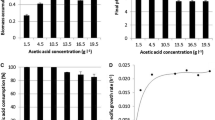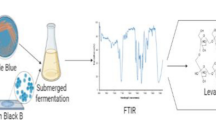Abstract
Pectinatus frisingensis, a recently described species of anaerobic mesophilic beer-spoilage bacteria, grows by fermenting various organic compounds, and produces mainly propionate, acetate, and succinate. Although acrylate and succinate were both dismutated by dense resting-cell suspensions, propionate production proceeded through the succinate pathway: [3-13C]pyruvate consumption led to equal 13C-labeling of propionate on methyl and methylene groups. Growth on glucose or glycerol led to a similar propionate to acetate ratio, suggesting dihydroxyacetone phosphate as being a common metabolic intermediate. Diacetyl, 1,3-propanediol, and 2,3-butanediol were not growth substrates or fermentation products, but they were all dismutated by dense resting-cells suspensions to acetate and propionate. Acetoin was a minor fermentation product. The consumption of [2-13C] or [3-13C]pyruvate by dense resting-cell suspensions demonstrated the involvement of two equivalent pyruvate molecules during acetoin production. Key enzymes involved in this metabolism were measured in anoxic cell-free extracts. A tentative metabolic pathway to the main fermentation products was proposed from the above results.
Similar content being viewed by others
References
Allen SHG, Kellermeyer RW, Stjernholm RL, Wood HG (1964) Purification and properties of enzymes involved in the propionic acid fermentation. J Bacteriol 87:171–187
Back W, Weiss N, Seidel H (1979) Isolierung und systematische Zuordnung bierschädlicher Bakterien. II. Gram-negative anaerobe Stäbchen. Brauwiss 32:233–238
Bergsma J, Dongen MBM van, Konings WN (1982) Purification and characterization of NADH dehydrogenase from Bacillus subtilis. Eur J Biochem 128:151–157
Boonstra J, Huttunen MT, Konings WN (1975) Anaerobic transport in Escherichia coli membrane vesicles. J Biol Chem 250: 6792–6798
Buckel W, Dorn U, Semmler R (1981) Glutaconate-CoA transferase from Acidaminococcus fermentans. Eur J Biochem 118: 315–321
Delwiche EA, Phares EF, Carson SF (1956) Succinic acid decarboxylation system in Propionibacterium pentosaceum and Veillonella gazogenes. I. Activation, decarboxylation, and related reactions. J Bacteriol 71:598–603
Dijkhuizen L, Werf B van der, Harder W (1980) Metabolic regulation in Pseudomonas oxalaticus OX1. Diauxic growth on mixtures of oxalate and formate or acetate. Arch Microbiol 124: 261–268
Doelle HW (1975) Bacterial metabolism, 2nd edn. Academic Press. New York, London
Dolin MI, Gunsalus IC (1951) Pyruvic acid metabolism. II. An acetoin-forming enzyme system in Streptococcus faecalis. J Bacteriol 62:199–214
Eichler B, Schink B (1985) Fermentation of primary alcohols and diols and pure culture of syntrophically alcohol-oxidizing anacrobes. Arch Microbiol 143:60–66
Evans CT, Sumegi B, Srere PA, Sherry AD, Malloy CR (1993) [13C]Propionate oxidation in wild-type and citrate synthase mutant Escherichia coli: evidence for multiple pathways of propionate utilization. Biochem J 291:927–932
Galivan JH, Allen SHG (1968) Methylmalonyl coenzyme A decarboxylase. Its role in succinate decarboxylation by Micrococcus lactilyticus. J Biol Chem 243:1253–1261
Haikara A, Enari TM, Lounatmaa K (1981) The genus Pectinatus, a new group of anaerobic beer spoilage bacteria. Proceedings of the 20th Congress of the European Brewer Convention, Copenhagen, pp 229–240
Haikara A (1985) Detection of Pectinatus contaminants in beer. J Am Soc Brew Chem 43:43–45
Halpern YS, Even-Shoshan A (1967) Further evidence for two distinet acetolactate synthetases in Aerobacter aerogenes. Biochim Biophys Acta 139:502–504
Hilpert W, Dimroth P (1982) Conversion of the chemical energy of methylmalonyl-CoA decarboxylation into a Na+ gradient. Nature 296:584–585
Hilpert W, Dimroth P (1983) Purification and characterization of a new sodium-transport decarboxylase methylmalonyl-CoA decarboxylase from Veillonella alcalescens. Eur J Biochem 132: 579–587
Hilpert W, Schink B, Dimroth P (1984) Life by a new decarboxylation-dependent energy conservation mechanism with Na+ as coupling ion. EMBO J 3:1665–1670
Houwen FP, Dijkema C, Schoenmakers CHH, Stams AJM, Zehnder AJB (1987) 13C-NMR study of propionate degradation by a methanogenic coculture. FEMS Microbiol Lett 41:269–274
Houwen FP, Dijkema C, Stams AJM, Zehnder AJB (1991) Propionate metabolism in anaerobic bacteria: determination of carboxylation reactions with 13C-NMR spectroscopy. Biochim Biophys Acta 1056:126–132
Lee SY, Mabee MS, Jangaard NO (1978) Pectinatus, a new genus of the family Bacteroidaceae. Int J Syst Bacteriol 28:582–594
Lindley RW, Delwiche EA (1969) Degradation of α-ketoglutarate by Veillonella alcalescens. J Bacteriol 98:315–316
Lowry OH, Rosenbrough NJ, Farr AL, Randal RJ (1951) Protein measurement with the Folin phenol reagent. J Biol Chem 163:265–275
Macy JM, Ljungdahl LG, Gottschalk G (1978) Pathway of succinate and propionate formation in Bacteroides fragilis. J Bacteriol 134:84–91
Maeba P, Sanwal BD (1969) Phosphoenolpyruvate carboxylase from Salmonella typhimurium strain LT 2. Methods Enzymol 13:283–288
Miller TL, Wolin MJ (1974) A serum bottle modification of the Hungate technique for cultivating obligate anaerobes. Appl Environ Microbiol 27:985–987
Nakajima H, Suzuki K, Imahori K (1978) Purification and properties of acetate kinase from Bacillus stearothermophilus. J Biochem 84:193–203
Ng SKC, Hamilton IR (1971) Lactate metabolism by Veillonella parvula. J Bacteriol 105:999–1005
Oberlies G, Fuchs G, Thauer RK (1980) Acetate thiokinase and the assimilation of acetate in Methanobacterium thermoautotrophicum. ArchMicrobiol 128:248–252
Pankhania IP, Spormann AM, Hamilton WA, Thauer RK (1988) Lactate conversion to acetate, CO2, and H2 in cell suspensions of Desulfovibrio vulgaris (Marburg): indication for the involvement of an energy driven reaction. Arch Microbiol 150:26–31
Peck HD, Gest H (1956) A new procedure for assay of bacterial hydrogenases. J Bacteriol 71:70–80
Rainbow C (1981) Beer spoilage microorganisms. In: Pollock JRA (ed) Brewing science, vol 2. Academic Press, New York London, pp 491–551
Rand MC, Greenberg AE, Taras MJ, Franson MA (1976) Standards methods for the examination of water and wastewater. American Public Health Association, Washington, DC
Samain E, Albagnac D, Dubourguier HC, Touzel JP (1982) Characterization of a new propionic acid bacterium that ferments ethanol and displays a growth factor-dependent association with a gram negative homoacetogen. FEMS Microbiol Lett 15:69–74
Schink B, Kremer DR, Hansen TA (1987) Pathway of propionate formation from ethanol in Pelobacter propionicus. Arch Microbiol 147:321–327
Schleifer KH, Leuteritz M, Weiss N, Ludwig W, Kirchhof G, Seidel-Rüfer H (1990) Taxonomic study of anaerobic, gram-negative, rod-shaped bacteria from breweries: emended description of Pectinatus cerevisiiphilus and description of Pectinatus frisingensis sp. nov., Selenomonas lacticifex sp. nov., Zymophilus raffinosivorans gen. nov., sp. nov., and Zymophilus paucivorans sp. nov. Int J Syst Bacteriol 40:19–27
Schütz H, Radler F (1984) Propanediol-1,2-dehydratase and metabolism of glycerol of Lactobacillus brevis. Arch Microbiol 139:366–370
Schweiger G, Buckel W (1984) On the dehydration of (R)-lactate in the fermentation of alanine to propionate by Clostridium propionicum. FEBS Lett 171:79–84
Stams AJM, Hansen TA (1982) Oxygen-labile l(+) lactate dehydrogenase activity in Desulfovibrio desulfuricans. FEMS Microbiol Lett 13:389–394
Stams AJM, Kremer DR, Nicolay K, Weenk GH, Hansen TA (1984) Pathway of propionate formation in Desulfobulbus propionicus. Arch Microbiol 139:167–173
Takahashi N (1983) Presumed Pectinatus strains isolated from Japanese beer. Bull Brew Sci 28:11–14
Tholozan JL, Samain E, Grivet JP, Moletta R, Dubourguier HC, Albagnac G (1988a) Reductive carboxylation of propionate to butyrate in methanogenic ecosystems. Appl Environ Microbiol 54:441–445
Tholozan JL, Samain E, Grivet JP (1988b) Isomerization between n-butyrate and iso-butyrate in enrichment cultures. FEMS Microbiol Ecol 53:187–191
Tholozan JL, Touzel JP, Samain E, Grivet JP, Prensier G, Albagnac G (1992) Clostridium neopropionicum sp. nov., a strict anaerobic bacterium fermenting ethanol to propionate through acrylate pathway. Arch Microbiol 157:249–257
Toraya T, Ushio K, Fukui S, Hogenkamp HPC (1977) Studies on the mechanism of the adenosylcobalamin-dependent diol dehydrase reaction by the use of analogs of the coenzyme. J Biol Chem 252:963–970
Toraya T, Honda S, Fukui S (1979) Fermentation of 1,2-propanediol and 1,2-ethanediol by some genera of Enterobacteriacae, involving coenzyme B12-dependent diol dehydratase. J Bacteriol 139:39–47
Touzel JP, Petroff D, Albagnac G (1985) Isolation and characterization of a new thermophilic Methanosarcina, the strain CHTI 55. Syst Appl Microbiol 6:66–71
Wood HG, Stjernholm R, Leaver FW (1956) The role of succinate as a precursor of propionate in the propionic acid fermentation. J Bacteriol 72:142–152
Wood WA, Werkman CH (1936) Mechanism of glucose dissimilation by the propionic acid bacteria. Biochem J 30:618–623
Wood WA (1961) Fermentation of carbohydrates and related compounds. In: Gunsalus IC, Stanier RY (eds), The Bacteria, vol 2. Metabolism. Academic Press, New York London, pp 59–150
Zeikus JG, Fuchs G, Kenealy W, Thauer RK (1977) Oxidoreductases involved in cell carbon synthesis of Methanobacterium thermoautotrophicum. J Bacteriol 132:604–613
Author information
Authors and Affiliations
Rights and permissions
About this article
Cite this article
Tholozan, JL., Grivet, JP. & Vallet, C. Metabolic pathway to propionate of Pectinatus frisingensis, a strictly anaerobic beer-spoilage bacterium. Arch. Microbiol. 162, 401–408 (1994). https://doi.org/10.1007/BF00282104
Received:
Accepted:
Issue Date:
DOI: https://doi.org/10.1007/BF00282104




